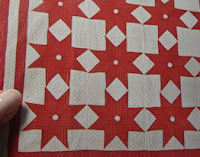I was very lucky to receive a copy of Red & White Quilts: Infinite Variety for Christmas. I've been slowly absorbing it's riches over the past weeks and have spent many happy hours in the wordless pages. What a treat! The book is essentially a catalog of the show, which entered the collective consciousness of the quilt and art world in 2011. Infinite Variety showcased the private collection of Joanna S. Rose, who focused entirely on red and white quilts. An online search reveals a few images of the display system (which is amazing) and the exhibit from a distance, along with a frustratingly small sample of quilts.
For years, YEARS, quilt lovers have been clamoring for two things: 1) more information about the quilts and 2) the exhibit to travel. Well, we have part of the first in this book. A few pages are dedicated to a history of the exhibit, it's technical aspects, and a history of red and white quilts. Following those are stunning photos of the exhibit itself. The remainder of the book is dedicated to the quilts, all 653 of them.
As pointed out by the curators, Elizabeth Warren and Maggi Gordon, placing quilts into categories can be a challenge. Names of patterns are flexible, so what I may know as Delectable Mountain is called something else by another. Some quilters used settings that are unusual, placing their quilt into a category we wouldn't use today. Dating was also an issue. Most of the quilts were not signed, so there is a frustrating lack of information to go with the images. Because of the cloth used, most of the quilts were dated to the period between 1880 and 1920. But for all the information that isn't available, the reader/viewer is not left lacking. The quilts speak for themselves.
After spending so much time with this book, I tried to narrow my favorites to a few special quilts - crazy, I know. The book is full of stunners- beautiful and complex artworks. I realize, though, that I am drawn to the odd quilts, the ones that leave you wondering. An example is the Ocean Waves quilt with the gold blocks, shown above at right. Did the quilter run out of red? Was this a different kind of cloth that has since faded? Was this artistic expression, or just a way to get the quilt finished. We'll never know.
I fell in love with an Eight Point star quilt that, at first glance, is quite plain. The stars are large (I calculate over 16") and the quilting is a simple, allover cross-hatch. But then, there are these white circles appliqued in the center of the stars. Just a tiny change and this becomes a very different quilt. I can't take my eyes off it.
I have never been a fan of Lone Star quilts. To me they are predictable and dull. I know the block is tricky to piece, and I appreciate the endeavors of others, but I would never have one of these quilts in my home. However, I would make an exception for the wacky 16 pointed Lone Star in the Rose Collection. This eye-popper has me perplexed! For some reason the quilter lopped off the top and bottom of those respective points. The "star" looks skewed and stretched, and you think the quilt should be a rectangle, but somehow it manages to remain square. And so many points! Your eye just goes around and around and around. Oh, I love this one.
From a quilt designers point of view, this book is a valuable resource. Ms. Rose bought what she liked, not paying any attention to what she already had, or perceived gaps in her collection. The result is many variations of a particular design. You would think over ten Drunkard's Path quilts would be pretty similar, but no, each is unique and has something to teach about scale, pattern and texture. I had to look carefully to detect what made this example different from its neighbors. No longer a quarter circle, the shallower curve used in this block would be easier to sew, but more importantly, the change of shape gives the overall pattern a "swing" missing in a typical Drunkard's Path.
This is an excellent book, highly recommended for quilters and art lovers alike. As for the exhibit traveling to other venues, there is a hint in the book that there are efforts being made to realize the dream. Until then, we finally have pictures of the quilts. We'll have to be content with that.






No comments:
Post a Comment